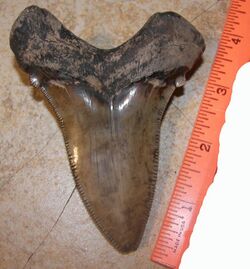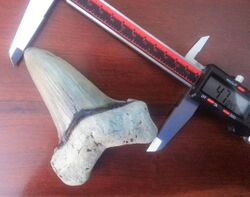Biology:Carcharocles angustidens
| Carcharocles angustidens | |
|---|---|

| |
| Scientific classification | |
| Domain: | Eukaryota |
| Kingdom: | Animalia |
| Phylum: | Chordata |
| Class: | Chondrichthyes |
| Subclass: | Elasmobranchii |
| Subdivision: | Selachimorpha |
| Order: | Lamniformes |
| Family: | †Otodontidae |
| Genus: | †Carcharocles |
| Species: | †C. angustidens
|
| Binomial name | |
| †Carcharocles angustidens Agassiz, 1843
| |
| Synonyms | |
|
Carcharodon angustidens Agassiz, 1843 | |
Carcharocles angustidens is a species of prehistoric megatoothed sharks in the genus Carcharocles, which lived during the Oligocene and Miocene epochs about 33 to 22 million years ago.[1] This shark is related to another extinct megatoothed shark, Carcharocles megalodon.[1]
Taxonomy
The Swiss naturalist Louis Agassiz, first identified this shark as a species of genus Carcharodon in 1835.
In 1964, shark expert, L. S. Glikman recognized the transition of Otodus obliquus to C. auriculatus and moved C. angustidens to genus Otodus. (See "external links" below)
However, in 1987, shark expert H. Cappetta recognized the C. auriculatus - C. megalodon lineage and placed all related megatooth sharks along with this species in the genus Carcharocles. The complete Otodus obliquus to C. megalodon transition then became clear and has since gained the acceptance of many other experts with the passage of time. Within the Carcharocles lineage, C. angustidens is the species succeeding C. sokolovi and is followed by C. chubutensis.[1]
In 2001, a discovery of the best preserved Carcharocles angustidens specimen to date by two scientists, Michael D. Gottfried and Ewan Fordyce, has been presented by the team as evidence for close morphological ties with the extant great white shark, and the team argued that Carcharocles angustidens, along with all other related megatooth sharks, including Carcharocles megalodon, should be assigned to Carcharodon as was done before by Louis Agassiz.,[2] although this is not internationally accepted by the scientific community.
Size estimation
Like other known megatooth sharks, the fossils of C. angustidens indicate that it was considerably larger than the extant great white shark, Carcharodon carcharias. The well preserved specimen from New Zealand is estimated at 9.3 m (31 ft) in length.[2] This specimen had teeth measuring up to 9.87 cm (3.89 in) in diagonal length, and vertebral centra around 1.10 cm (0.43 in) in diameter.[2] However, reports of larger C. angustidens fossils have been made.[3]
Dentition
The dental formula for C. angustidens is 2.1.5.43.0.6.3
Diet
C. angustidens was an apex predator and likely preyed upon penguins, fish, dolphins, and baleen whales.
Fossil record
As is the case with most extinct sharks, this species is also known from fossil teeth and some fossilized vertebral centra. Shark skeletons are composed of cartilage and not bone, and cartilage rarely gets fossilized. Hence, fossils of C. angustidens are generally poorly preserved. To date, the best preserved specimen of this species have been excavated from New Zealand, which comprises 165 associated teeth and about 35 associated vertebral centra.[2] This specimen is around 26 million years old. C. angustidens teeth are noted for their triangular crowns and small side cusps that are fully serrated. The serrations are very sharp and very well pronounced. C. angustidens was a widely distributed species with fossils found in:[4]
- North America
- Yazoo Formation, Alabama
- Jewett Sand Formation, California
- Clinchfield Formation, Georgia
- Calvert Formation, Maryland
- Jackson Group, Mississippi
- Kirkwood Formation, New Jersey
- Castle Hayne Formation, North Carolina
- Hawthorne Formation, South Carolina[3]
- Europe
- Asia
- Ashiya Group, Japan
- Oceania
- Ettric, Jan Juc, Gambier Limestone, Clifton Formations, Australia
- Otekaike Formation, New Zealand
- Africa[2]
- South America[2]
- Dos Bocas Formation, Ecuador
See also
- Prehistoric fish
- Largest prehistoric organisms
References
- ↑ 1.0 1.1 1.2 Renz, Mark (2002). Megalodon: Hunting the Hunter. PaleoPress. pp. 26–30. ISBN 0-9719477-0-8
- ↑ 2.0 2.1 2.2 2.3 2.4 2.5 Gottfried M.D., Fordyce R.E (2001). "An associated specimen of Carcharodon angustidens (Chondrichthyes, Lamnidae) from the Late Oligocene of New Zealand, with comments on Carcharodon interrelationships". Journal of Vertebrate Paleontology 21 (4): 730–739. doi:10.1671/0272-4634(2001)021[0730:AASOCA2.0.CO;2].
- ↑ 3.0 3.1 "C. angustidens fossils from Black River Fossils". http://www.blackriverfossils.org/SharkTeeth/Carcharoclesangustidens/tabid/53/Fossils/1894/Default.aspx.
- ↑ Carcharocles angustidens at Fossilworks.org
Further reading
- Glikman, L.S., 1980. Evolution of Cretaceous and Caenozoic Lamnoid Sharks:3-247, pls.1-33. Moscow.
- Jordan, D.S. & Hannibal, H., 1923. Fossil Sharks and Rays of the Pacific Slope of North America. Bulletin of the Southern California Academy of Sciences, 22:27-63, plates 1–9.
External links
- A large extinct white shark: Carcharodon angustidens from New Zealand Oligocene rocks.
- Carcharocles: Extinct Megatoothed shark
Wikidata ☰ Q5038154 entry


